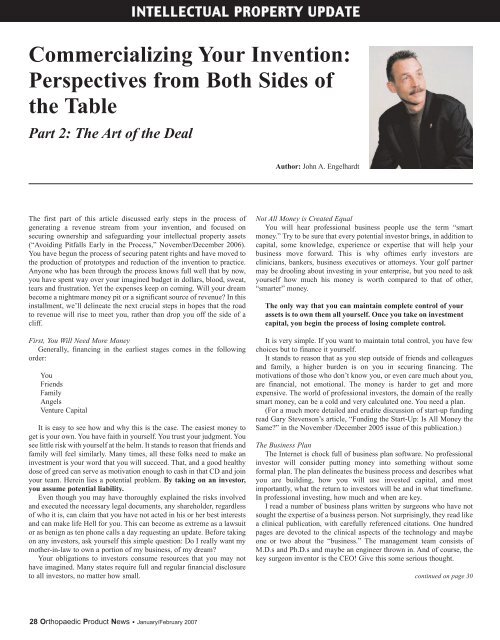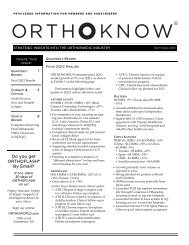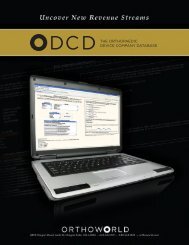AAOS, Arthroscopy - Orthoworld
AAOS, Arthroscopy - Orthoworld
AAOS, Arthroscopy - Orthoworld
Create successful ePaper yourself
Turn your PDF publications into a flip-book with our unique Google optimized e-Paper software.
INTELLECTUAL PROPERTY UPDATECommercializing Your Invention:Perspectives from Both Sides ofthe TablePart 2: The Art of the DealAuthor: John A. EngelhardtThe first part of this article discussed early steps in the process ofgenerating a revenue stream from your invention, and focused onsecuring ownership and safeguarding your intellectual property assets(“Avoiding Pitfalls Early in the Process,” November/December 2006).You have begun the process of securing patent rights and have moved tothe production of prototypes and reduction of the invention to practice.Anyone who has been through the process knows full well that by now,you have spent way over your imagined budget in dollars, blood, sweat,tears and frustration. Yet the expenses keep on coming. Will your dreambecome a nightmare money pit or a significant source of revenue? In thisinstallment, we’ll delineate the next crucial steps in hopes that the roadto revenue will rise to meet you, rather than drop you off the side of acliff.First, You Will Need More MoneyGenerally, financing in the earliest stages comes in the followingorder:YouFriendsFamilyAngelsVenture CapitalIt is easy to see how and why this is the case. The easiest money toget is your own. You have faith in yourself. You trust your judgment. Yousee little risk with yourself at the helm. It stands to reason that friends andfamily will feel similarly. Many times, all these folks need to make aninvestment is your word that you will succeed. That, and a good healthydose of greed can serve as motivation enough to cash in that CD and joinyour team. Herein lies a potential problem. By taking on an investor,you assume potential liability.Even though you may have thoroughly explained the risks involvedand executed the necessary legal documents, any shareholder, regardlessof who it is, can claim that you have not acted in his or her best interestsand can make life Hell for you. This can become as extreme as a lawsuitor as benign as ten phone calls a day requesting an update. Before takingon any investors, ask yourself this simple question: Do I really want mymother-in-law to own a portion of my business, of my dream?Your obligations to investors consume resources that you may nothave imagined. Many states require full and regular financial disclosureto all investors, no matter how small.Not All Money is Created EqualYou will hear professional business people use the term “smartmoney.” Try to be sure that every potential investor brings, in addition tocapital, some knowledge, experience or expertise that will help yourbusiness move forward. This is why oftimes early investors areclinicians, bankers, business executives or attorneys. Your golf partnermay be drooling about investing in your enterprise, but you need to askyourself how much his money is worth compared to that of other,“smarter” money.The only way that you can maintain complete control of yourassets is to own them all yourself. Once you take on investmentcapital, you begin the process of losing complete control.It is very simple. If you want to maintain total control, you have fewchoices but to finance it yourself.It stands to reason that as you step outside of friends and colleaguesand family, a higher burden is on you in securing financing. Themotivations of those who don’t know you, or even care much about you,are financial, not emotional. The money is harder to get and moreexpensive. The world of professional investors, the domain of the reallysmart money, can be a cold and very calculated one. You need a plan.(For a much more detailed and erudite discussion of start-up fundingread Gary Stevenson’s article, “Funding the Start-Up: Is All Money theSame?” in the November /December 2005 issue of this publication.)The Business PlanThe Internet is chock full of business plan software. No professionalinvestor will consider putting money into something without someformal plan. The plan delineates the business process and describes whatyou are building, how you will use invested capital, and mostimportantly, what the return to investors will be and in what timeframe.In professional investing, how much and when are key.I read a number of business plans written by surgeons who have notsought the expertise of a business person. Not surprisingly, they read likea clinical publication, with carefully referenced citations. One hundredpages are devoted to the clinical aspects of the technology and maybeone or two about the “business.” The management team consists ofM.D.s and Ph.D.s and maybe an engineer thrown in. And of course, thekey surgeon inventor is the CEO! Give this some serious thought.continued on page 3028 Orthopaedic Product News • January/February 2007
















